With its glorious plumage and resplendent colors, the peafowl looks like the royalty of the animal kingdom.
This doesn’t mean these birds dine on cakes and caviar, however. No, being animals, they primarily consume the icky stuff, like bugs, mice, worms, and frogs.
But how do wild peacocks differ from pet peacocks when it comes to their diet? And what, exactly, do these birds eat?
Keep reading to find out!
Note: while these birds are popularly known as “peacocks,” the proper, gender-neutral term for the species is “peafowl.” Peacocks are male peafowl, while peahens are female peafowl.
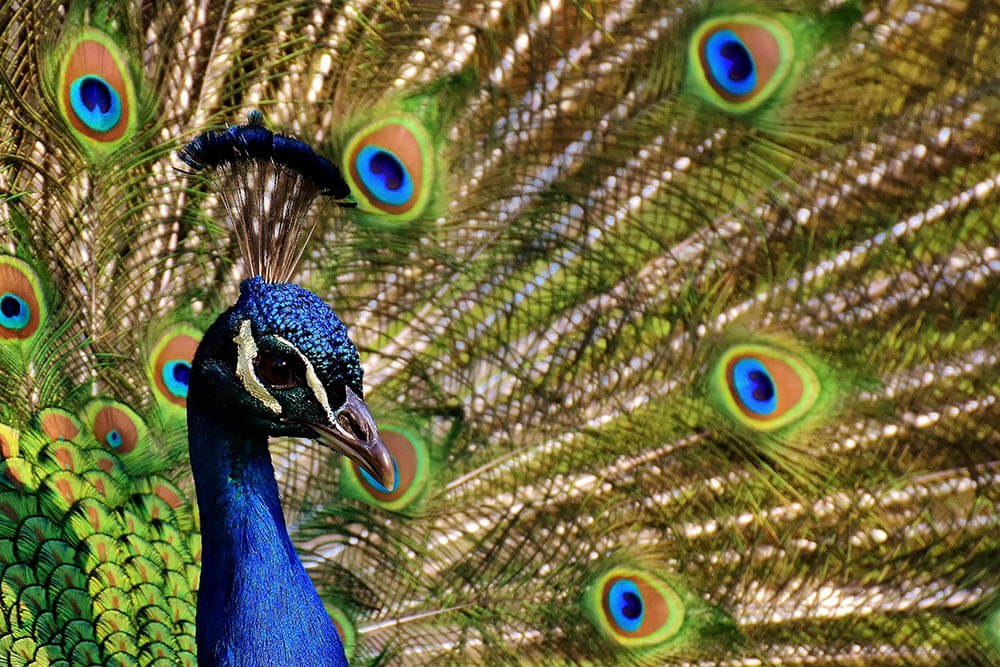
Peafowl Dietary Habits in Brief
Peafowl are omnivores, which means they eat both plant and animal matter. In the wild, they forage for grasses, leaves, insects, tiny rodents, lizards, and the like. Pet owners are advised to emulate this natural diet for their captive peafowl.
These birds are opportunistic with a tendency toward scavenging, so they’ll eat whatever’s available. They’re also known to rummage through trash for goodies and even chase people if they smell a snack on them. As long as something fits in their mouth, it’ll end up in their belly!
In their natural habitat, these birds form large groups that then subdivide into smaller groups during the daytime. These smaller units are responsible for foraging. They typically take a break come mid-day, resting in the shade and preening their feathers, before resuming their search for food. Once darkness falls, they regroup and conceal themselves amongst the trees to sleep.
Outside the mating season, these small foraging groups often consist of an equal number of males and females. During the mating season, however, a single dominant male and a harem of breeding females make up one group, while teams of bachelors compose the other groups.
Where a peafowl lives and what time of the year it is determines the types of foods it consumes. You can therefore expect a peafowl in India to feed on a different range of foods than a peafowl that calls the Congo its home. These birds play a crucial ecological role by controlling the populations of insects, lizards, snakes, and other animals in a region. Without peafowl, these other animals could grow too numerous, which can throw the region’s ecosystem into chaos.
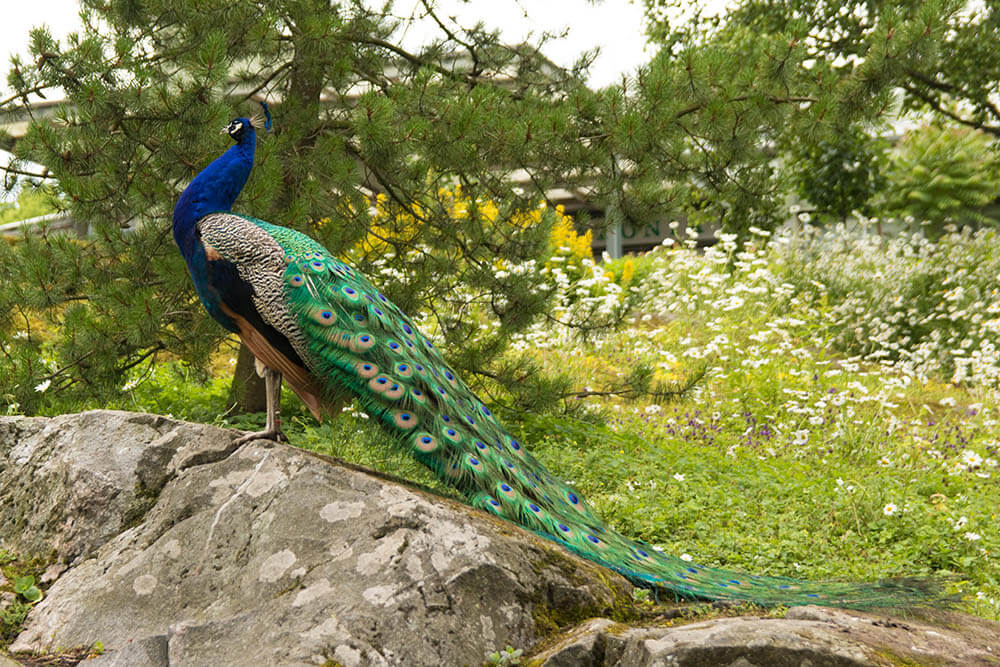
What Peafowl Eat in the Wild
Peafowl are obsessed with eating and enjoy a wide variety of foods.
The foods these birds eat can be separated into two main categories: animal and plant matter:
Animal matter
Meat is an excellent source of protein.
Like all animals, peacocks and peahens need protein for strong, healthy bones. And like other birds, they also need this nutrient so that their feathers can grow strong enough to support flight and provide them with insulation against the cold. In fact, feathers are around 90% protein, while the protein found in these feathers makes up about 25% of a bird’s total protein content.
Below are some examples of the types of meat peafowl consume:
Insects, arachnids, and worms
- Ants
- Beetles
- Butterflies
- Crickets
- Flies
- Grubs
- Mealworms
- Millipedes
- Spiders
- Worms
Reptiles and amphibians
- Frogs
- Lizards
- Small snakes
Mammals
- Mice
- Other small rodents
Gastropods
- Slugs
- Small snails
Peafowl aren’t picky when it comes to food; they’ll readily gobble up any tiny creatures that come their way.
Wherever these birds are located, you’ll often find them clawing at the dirt in search of grubs and worms, or ripping up flowers to look for snails. They also devour small reptiles and mammals unfortunate enough to cross their path.
Plant matter
Peafowl also eat fruits, vegetables, and other plant matter as these foods boast many nutrients essential to their health.
Below are a few examples of the plant matter these birds typically feed on:
Fruits
- Bananas
- Blackberries
- Cantaloupe
- Gallberries
- Grapes
- Huckleberries
- Muscadines
- Raspberries
- Tomatoes
- Watermelon
Vegetables
- Beans
- Bell peppers
- Cabbage
- Kale
- Peanuts
- Peas
Grains
- Corn
- Oats
- Wheat
Miscellaneous
- Alfalfa
- Figs
- Flowers
- Grass
- Leaves
- Seeds
Wild peafowl enjoy plant matter that they find in their natural habitat. However, they sometimes raid farms to steal cultivated crops like peppers and tomatoes.
These birds typically don’t consume the pulp of fruits and veggies, but they do tear these foods apart to access the seeds inside, which they enjoy eating.
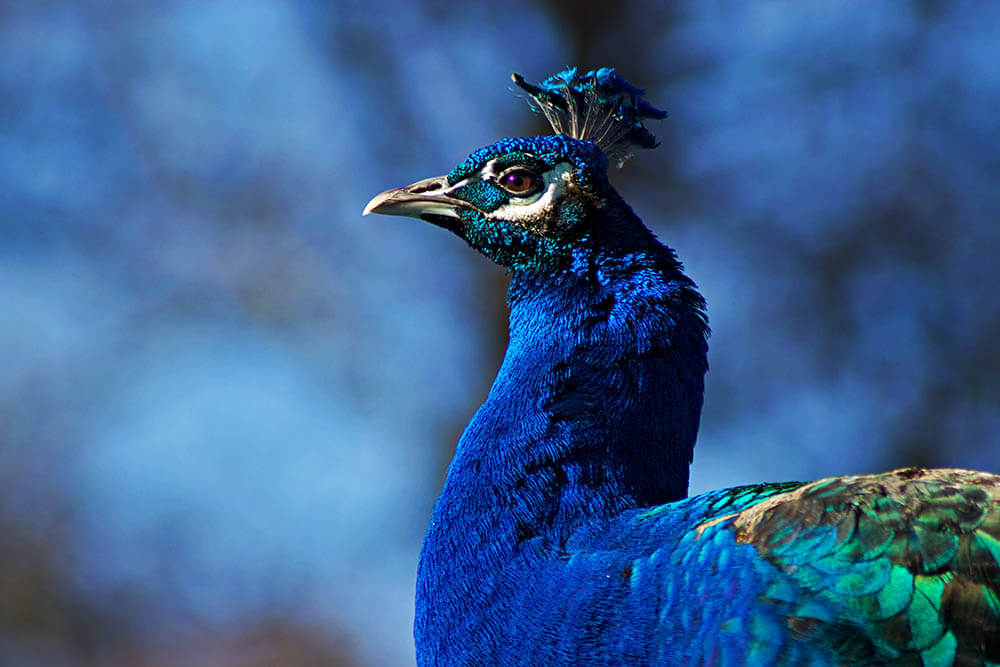
What Peafowl Eat as Pets
You should feed a peafowl in captivity a close approximation of what it would eat in the wild. This means giving it vegetables, fruits, and other types of plant matter, as well as small creatures like insects and rodents. You can purchase many of these foods at supermarkets and groceries, while exotic pet stores sell live and dried varieties of tiny creatures suitable for peafowl consumption.
A free-ranging pet peafowl will explore your yard in search of insects, lizards, frogs, rodents, and other edibles. As it only has a limited space to roam, however, its foraging activities don’t always result in success. It’s therefore your responsibility as its keeper to ensure it gets the animal protein it needs to stay healthy.
It’s also a good idea to feed a captive peafowl a supplemental diet consisting of commercial livestock feed and pet food. Give such foods to your peafowl in conjunction with the other foods described above.
Commercial livestock/bird feed
Commercial livestock/bird feed are often concentrated grains.
While it’s best to use livestock feed that’s specifically formulated for peafowl, types formulated for other birds, such as pheasants and turkeys, are also good choices.
Livestock feed should make up around a third of your pet’s diet.
Pet foods
Pet foods include dry dog food and/or cat food. These contain nutrients such as vitamins and minerals that typical peafowl foods lack but that these creatures can benefit from. They’re also high in protein.
Feed your pet these pet foods as an occasional treat only, as too much could lead to problems.
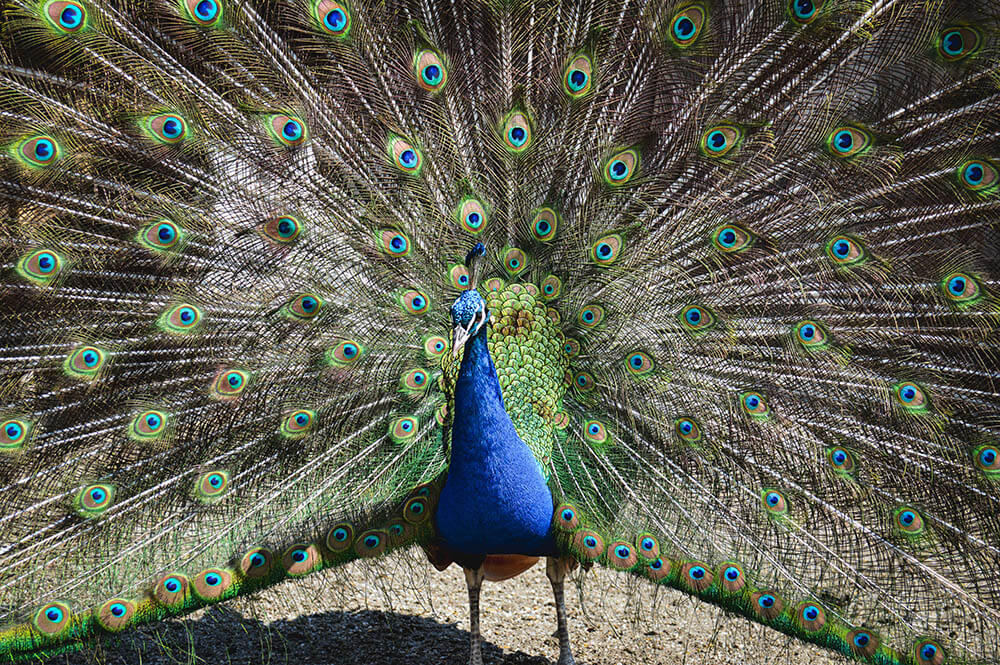
What Peafowl Shouldn’t Eat
Generally speaking, most human foods are bad for peacocks and peahens.
Peafowl shouldn’t be fed processed foods, as these contain preservatives, sugar, colorants, and other substances that can harm them.
Other human foods don’t contain the nutrients peafowl need to stay healthy, while others come with an excess of nutrients.
If you own a peafowl, never feed it the following human foods:
- Bread
- Candy
- Cheese
- Chips
- Chocolate
- Dairy
- Processed meat
If, after eating such foods, your peafowl experiences digestive problems such as vomiting and/or diarrhea or other health concerns such as lethargy, contact a peafowl veterinarian immediately. Make sure to act quickly to prevent its condition from worsening!
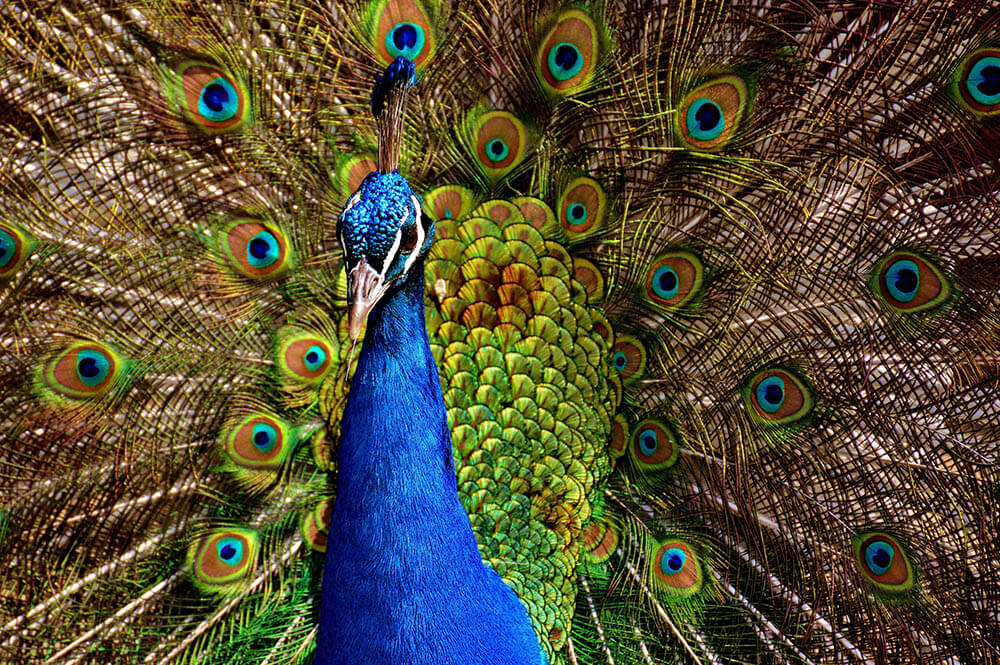
Fabulous Peafowl Facts
There’s more to peafowl than the foods they eat! So check out the following peafowl facts to learn more about these fascinating creatures!
They swallow pebbles
Peafowl ingest small stones and store them in a specialized organ called a gizzard, which is found near the digestive system. This organ assists in the grinding of tough plant material.
They’re sexually dimorphic
Male peafowl, or peacocks, don’t look the same as female peafowl, or peahens. Those peafowl boasting vibrant blues and other colors as well as eye-catching decorative tail feathers? Those are peacocks. Peahens, while also beautiful, have subtler colors such as brown and gray.
Only peacocks fan out their gorgeous tail feathers – a behavior known as “train rattling” that they engage in whenever they want to impress the ladies.
Those exquisite tail feathers take years to develop
Young peacocks and peahens look identical. A peacock has to wait around three months before his tail feathers start showing some color. And it’s only when a peacock becomes fully mature at three years of age that said tail feathers transform into an exhibition of mesmerizing colors and design.
They can fly
Despite their long, heavy tail feathers, peafowl are capable of flying short distances. This allows them to perch on tree branches whenever they need to rest at night or escape predators.
Peacocks molt
Once the mating season concludes, a peacock goes through a molting process during which he naturally sheds his tail feathers. Before the next mating season, these feathers grow back, only they’re longer and fuller.
Peahen crests are sensors
Because of the peafowl’s stunning plumage, we often overlook the equally magnificent decoration sitting on top of its head: the crest.
While both peacocks and peahens have crests, peahen crests are not only beautiful but also important, as they act as sensors during mating. When a peacock rattles his tail feathers to attract peahens, a peahen sees this display as well as feels its movements thanks to her crest.
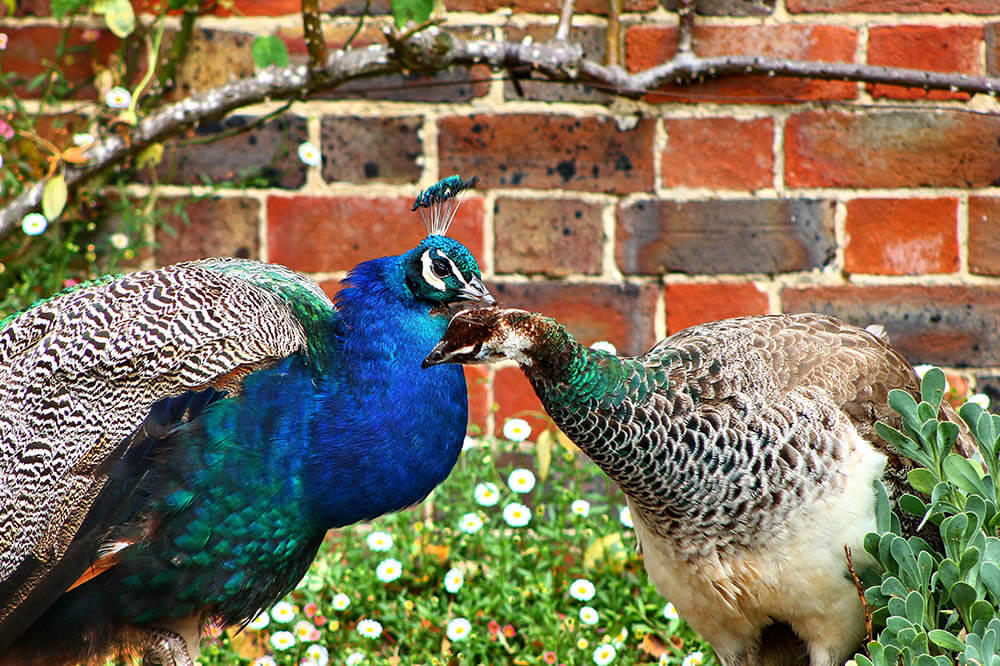
Conclusion
Peafowl eat a wide range of foods, including insects, rodents, reptiles, veggies, fruits, and grains. And as opportunistic scavengers that enjoy eating, they tend to consume just about anything they find in front of their beaks.
The captive peafowl diet shouldn’t be too different from the wild peafowl’s. If you own one of these majestic creatures, it’s therefore your responsibility to ensure you can provide it with foods similar to those enjoyed by its wild counterparts. Thankfully, many of the things these birds eat are readily available in most exotic pet stores, supermarkets, and groceries. Don’t forget to treat a pet peafowl to bird feed and pet foods, as well!
